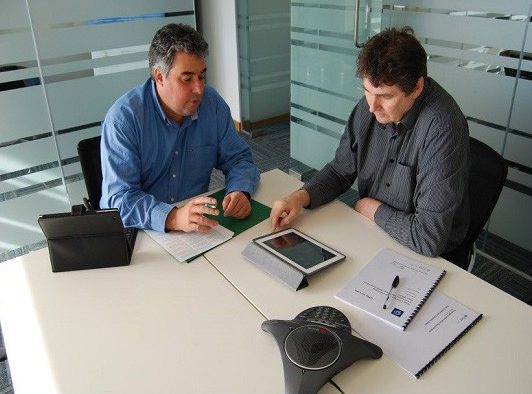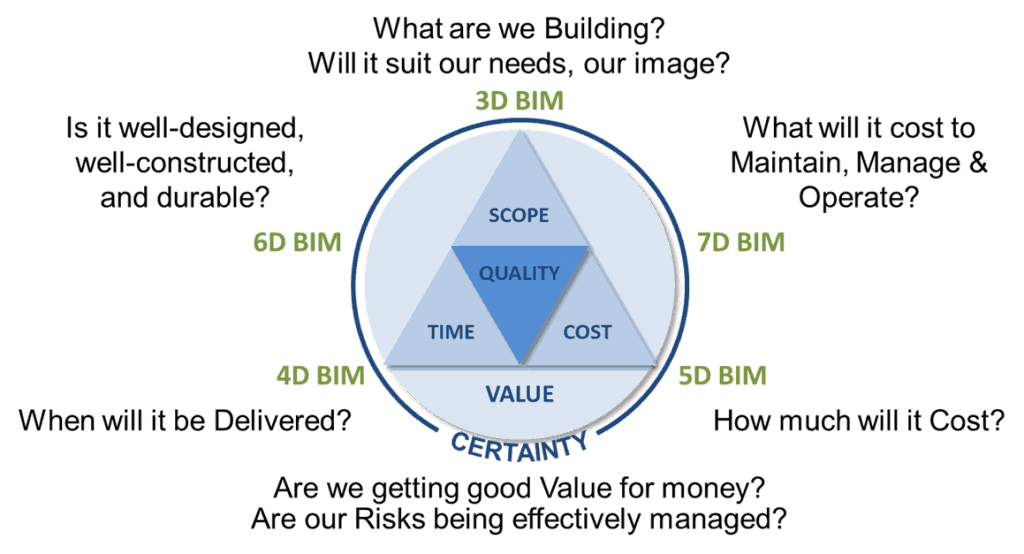What do you need to know about BIM, as a Project Manager? Why is BIM important? What is your role in the BIM process? BIMIreland.ie asked Ralph Montague, Managing Partner of ArcDox, Ireland’s leading BIM consultancy practice, for some advice for project managers. Ralph is a part-time lecturer on the Post-Graduate Diploma in Project Management, at Trinity College Dublin, and on BIM for Project Management.
“Project managers have a very important role to play, to help clients achieve their objective, for on-time delivery, within budget, at optimal quality, with zero accidents, with optimised operational or lifecycle cost, and reduced environmental impact“, says Ralph Montague, “and technology and processes like BIM can really help balance all these things, and allow better engagement of all the stakeholders”.
This article covers: (hyperlinks to section)
- Why do you need BIM on the project?
- How do you determine if BIM should be required? Is there a need for BIM?
- How do you assess BIM capability of the team?
- BIM must be a “contractual” requirement on the project.
- Who’s in charge of “Information Management”?
- Is the BIM project covered by Professional Indemnity Insurance?
- The project BIM Execution Plan (BEP)
- Make sure there are clearly defined “Information Deliverables” for the project
- How does BIM feed into what is truly important for Clients?
The professional project manager, acting as the client’s advisor, and client representative, must be engaged from the outset, to implement the control mechanisms, that will influence the direction of the project, and the project team, in the fast-paced effort to achieve the project objectives. It is a known fact that 36% of projects fail to deliver on the initial KPIs (key performance indicators), due to failed communication, or poor information, or focus on what matters. There are many benefits to using BIM as a communication tool, but BIM is not going to happen by accident, or by default – it has to be specified, and monitored, and the earlier, the better, in the project process. Project managers don’t need to be experts in BIM, but they need to understand their role in the process, and know when to bring in the right expertise. Timing is everything.
Why do you need BIM on the project?
The first question the project manager must answer for the client, is if BIM should be used on the project, and why it should be used. The answer will relate to how BIM can help the client control scope, time, costs, quality, safety and sustainability on projects, to ensure the client is getting value for money, and that their risks are being effectively managed. Taking “cost”, as an example, studies like “The Transformative Power of BIM”, suggest that digitalisation could lead to costs savings of 13-21% in design, engineering and construction phase, and 10-17% in the operations phase, which are very attractive or compelling reasons for using BIM. With potential benefits like these, it would be unprofessional and irresponsible, to not at least have a discussion about BIM, before the project starts.
See later section in the article “How does BIM feed into what is truly important for Clients?”
How do you determine if BIM should be required? Is there a need for BIM?
The first question to ask the client is whether there is a long-term need fully capture the “as-built” digital data, in a manner that will bring substantial efficiencies during the operational phase, or to extent this benefit to the future occupier. Does the client see the long-term benefit in explicitly demanding that the design and build team manage the “information” (drawings, schedules, specifications, bills of quantities, product data etc) using a digital BIM process to a recognised industry standard during the project? (the client is paying the team to do the work anyway, but do they value “data” over “paper”). If so, then BIM is a far more efficient and effective way of producing and managing information, as well as sharing and communicating that information with others. Using BIM will help reduce risk, effort, misunderstandings, delays, cost overruns and disputes. Using BIM also means your client can get good quality, digital, searchable, accessible and accurate information, at the end of the project, to improve the future operations and facilities management.
The requirements for BIM on the project are driven by 2 distinct business needs:
1). to have the “information” required to get building projects designed and constructed in an efficient & effective way – Project Information Model (PIM) Requirements.
2). to have the “information” required to maintain and operate the building in an efficient & effective way – Asset Information Model(AIM) Requirements.

Ralph Montague & Pat Slattery, Managing Partners, ArcDox
PAS1192 part 3, (currently in draft as ISO19650) is an industry standard for information management for the operational phase of projects that use BIM. It sets out the process of information management for post-construction phase or the Asset Information Requirements (AIR), and it determines what information is required in the Asset Information Model (AIM). This is the best place to start (i.e. start with the end in mind), and that should inform the requirements for any “project”.
PAS1192 part 2, sets out the process of information management for the design/construction phase of projects, or the Employers Information Requirements (EIR), and it determines what information is required in the Project Information Model (PIM).
Note, that AIM & PIM does not refer to 3D models, but to the full collection of Graphical Data, Non-Graphical Data, and Documents, held, and managed, in a Common Data Environment (CDE), including 3D models where available.
Copies of the above standard documents can be downloaded here http://bim-level2.org/en/standards/
The project manager’s role is to advise the client, regarding following industry standards, and that they need an Asset Information Requirement (AIR) and Employers Information Requirement (EIR), to establish, and communicate to the project team, the business need for BIM. Project managers should recommend engaging a BIM consultant at the earliest stage, to help the client prepare these key documents, if they don’t have the expertise in-house.
How do you assess BIM capability of the team?
The next question the project manager needs to ask, is whether the project team has the capability to use BIM. If the team has not been selected or appointed yet, then assessing the BIM capability of prospective team members can form part of the selection process. If the team has already been selected, the capability to use BIM should still be assessed, or the team’s willingness to obtain BIM capability and implement BIM on the project, before making a decision to proceed with BIM.
At the pre-qualification stage, you start by asking 4 simple questions in relation to each companies BIM policy and capability (taken from PAS91:2013 Section 4 Table 8):
- Do you have the capability of working with a project using a “Common Data Environment” as described in PAS 1192:2:2013?
- Do you have documented policy, systems and procedures to achieve “Level 2 BIM” maturity as defined.
- Do you have the capability of developing and delivering or working to (depending upon the role) a BIM Execution Plan (BEP) as described in PAS 1192:2:2013?
- Do you have arrangements for training employees in BIM related skills and do you assess their capabilities?
Before you engage (appoint, contract) any proposed team member, or supplier, the Project Manager should ask them to complete more detailed BIM capability assessment, as part of their pre-contract BIM Execution Plan (BEP), that includes an assessment of their IT infrastructure and human resources. See the Construction Project Information Committee templates as examples:
The above assessments will then be summarized and compiled into a Project Implementation Plan (PIP) as described in PAS1192-2 (see section 6 of PAS1192-2, which describes the “information” procurement process for design and construction services).
BIM must be a “contractual” requirement on the project.
One of the roles of project managers is to help the client get their appointments and contracts in place. If BIM is not a contractual requirement, then the team may try to avoid using it, and revert to traditional practices, which will then affect others ability to engage with BIM. The Construction Industry Council (CIC) in the UK have developed a standard BIM Protocol, which is a supplementary legal agreement, that can be incorporated into contractual documentation, establishing obligations, liabilities and limitations on the use of BIM. This needs to be appended to all appointments and contracts. The project manager should work with the legal team, to ensure that this happens. There is a project specific Model Production Delivery Table (MPDT) that also needs to be completed and appended to the BIM Protocol.
See more information on the BIM Protocol here http://www.bimtaskgroup.org/bim-protocol/
See a template for the Model Production Delivery Table (MPDT) here https://bimportal.scottishfuturestrust.org.uk/uploads/2017/1/mpdt-template-sft.xlsx
Who’s in charge of “Information Management”?
Like any successful project, up front planning is key. While the project manager may not be directly involved in information management, they do need to make sure that someone is put in charge, or it is not going to happen. It is important that the party responsible for coordinating the design, or executing the work, is also responsible for managing the information. Typically, the architect or lead designer would take on the role of Project Information Manager for the design stage, and the main contractor would take on the role during construction stage. The Construction Industry Council (CIC) in the UK have a standard Outline Scope of Service for Information Management, and the project manager should make sure this is incorporated into the scope of service for the appointment of the architect and main contractor. Part of this role, is setting up and maintaining the Common Data Environment (CDE), used by all parties to share and manage all the graphical data, non-graphical data, and documents for the project.
See the CIC Outline Scope of Service for Information Management here:
http://cic.org.uk/download.php?f=outline-scope-of-services-for-the-role-of-information-managment.pdf
Is the BIM project covered by Professional Indemnity Insurance?
Making sure the project is insured is another key role for project managers. The Construction Industry Council (CIC) in the UK have produced a guidance document regarding BIM and Professional Indemnity Insurance. The project manager needs to ensure that the project team are operating within the recommendations of that guidance, or it may be argued that the BIM project is at risk of not being covered by PI insurance. Key actions are to ensure the project team are using the CIC BIM Protocol, that they are following PAS1192-2 process, and that they have informed their PI Insurance company that they are working on a BIM project.
See the CIC Guidance Document here:
http://cic.org.uk/download.php?f=best-practice-guide-for-professional-indemnity-insurance-when-using-bim.pdf
The project BIM Execution Plan (BEP)
Another key role of the project manager is to make sure the project has a BIM Execution Plan (BEP) in place, that responds to the Employers Information Requirements (EIR), and that the project team are following their BEP to deliver the information as required. The post-contract BIM Execution Plan (BEP) will be produced and managed by the Project Information Manager (i.e. the architect or lead designer at design stage, and main contractor at construction stage), but the project manager will need to make sure that occurs, and check that it is being followed. The project manager will have some input into the BEP. The details of the BIM Execution Plan, are set out in section 6 & 7 of PAS1192-2
Make sure there are clearly defined “Information Deliverables” for the project
It is reported that 70% of projects finish over budget and behind schedule. One of the biggest reasons projects fail (36%) is “poor communication or information” – the wrong information, at the wrong time, in the wrong format, or missing information. It is very important to clearly set out what information is required, when it is required, and who is responsible for providing the information. Obviously, this is changing all the time, as the project develops, so this is an ongoing exercise. There are 3 tools that help the project manager (and the project team), to clearly define, understand and manage the “information deliverables”:
- The Model Production Delivery Table (MPDT)
- The Master Information Delivery Plan (MIDP)
- The Digital Plan of Work (DPoW)
There is a more detailed article about these tools here:
https://bimireland.ie/2017/07/07/clarifying-the-bim-project-deliverables-with-information-delivery-lists-and-bim/
While the project manager may not have to compile these lists, their role is to make sure they are completed, and that they are being used/referenced by the project team, to measure performance, and that they are being updated on a regular basis.
How does BIM feed into what is truly important for Clients?
Construction clients and developers have some primary concerns and questions, when it comes to their projects, and as a project manager you need to help deliver answers to those question.
Scope – clients want to understand what they are getting, and will it meet their need. The 3D visualisation aspects of BIM will really help everyone understand the scope, as many clients, and stakeholders, are not trained to read 2D drawings.
Time – clients want to understand how and when the project is going to be delivered. Linking the objects in the model to a construction programme or “time” (4D BIM), and visually “playing” through the sequence of construction, will help everyone understand the logistics and potential safety risks.
Cost – clients are obviously very interested in cost, not only the estimated or projected cost, but having more certainty on the actual final cost. They are interested in understanding that they are getting good value for money. The ability to extract accurate quantities from BIM, and link these to cost workbooks and cost database (5D BIM), will provide everyone with a much more transparent and certain estimate on costs.
Quality – clients are interested in the quality of the product they are going to receive. The ability to analyse the predicted performance of BIM, from a structural point or view, or energy point of view, and assessing the environmental impact (6D BIM), before making a large investment, is obviously very important. They don’t want to have to redo any work, or retrofit technologies after construction, to correct poor performing buildings. Also, understanding the long-term cost of operations of buildings is also important to some clients, and they will want more information to calculate the Total Cost of Ownership for the full lifecycle of the asset (7D BIM).
You can see from the above, that all these aspects of BIM (3D, 4D, 5D, 6D, 7D) are powerful tools to help the project manager deliver successful projects for clients, but as noted at the beginning of the article, these are not going to happen by accident, or by default. BIM is a powerful tool for effective project management, and the project manager plays a key role in the process. Project managers need enough understanding about BIM, to be able to converse with the client and project team, and get these aspects of BIM working for the project, if they are going to help deliver what clients really want.
The contents of this site are subject to copyright laws and may not be reproduced in any form without the prior consent of the publishers. The views expressed in articles do not necessarily represent those of the publishers.






